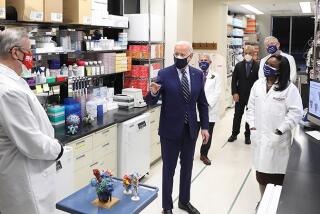Dispute Focuses on Who Invented ICU’s Device : Controversy Dogs ‘High Risk’ Needle
- Share via
Few people would dispute the usefulness of the so-called “High Risk” needle manufactured by ICU Medical Inc. But, considerable disagreement exists over who actually invented the device, designed to reduce the danger to doctors and nurses posed by contaminated needles.
And, that battle has reached to all the way to Washington, where federal officials have been asked to disregard a patent application filed by Mission Viejo-based ICU on behalf of its founder, Dr. George Lopez, whose claim is being challenged by a company shareholder and former colleague.
“I provided him with the idea and drawing in November of 1985,” said Dr. James Vanderhoof, who once practiced medicine with Lopez at a Norwalk medical group. “I thought he was one of my best friends.”
Vanderhoof says Lopez initially credited him as the inventor of the needle. But by May of 1986, just months after being given the drawings, Lopez began to tell investors that he developed the device, Vanderhoof claims.
Unlike conventional needles, the ICU needle has a sliding plastic sheath that covers the sharp tip of the needle after it is withdrawn from the patient, reducing the danger of doctors or nurses accidentally sticking themselves with a contaminated needle.
Self-stick accidents are surprisingly common, according to medical experts. A single needle prick can place a health care worker in danger of contracting hepatitis-B, and to a lesser degree, the deadly AIDS virus, says Dr. Julie Gerberding of San Francisco General Hospital.
“You can give this needle to your son to play with after you give it to an AIDS patient,” Lopez said in an earlier interview. Because of fear of AIDS, there was considerable demand for the needle long before it was even released, Lopez said at that time.
ICU applied for a patent on the needle a year ago. Early this year, Vanderhoof filed a protest with the U.S. Patent Office, contending that he is the needle’s true inventor. Kit Stetina, a Laguna Hills patent attorney representing Vanderhoof, said Friday that his client also has filed for a patent on the needle.
Ken Love, vice president of sales at ICU until early 1986, signed an affidavit that accompanied Vanderhoof’s protest. Love, now an executive with a Houston-based home health company, said Friday that Lopez originally acknowledged Vanderhoof as the needle’s inventor.
“The first time I was made aware of the concept, the stick-less needle was referred to as ‘Vanderhoof’s needle,’ ” Love said. “That’s how it started, and Lopez subsequently referred to it as ‘the Vanderhoof needle.’ ”
Lopez, who has since resigned his day-to-day duties at ICU, could not be reached for comment on Friday. However, Michael Varner, the company’s president and chief operating officer, stoutly denied Vanderhoof’s claim.
According to Varner, Lopez had asked Vanderhoof for advice while developing the needle, but none of the changes Vanderhoof suggested were ultimately incorporated into the device. “We are 100% sure that it’s ours,” he said.
“The concept was George’s (Lopez’s), and the product . . . is George’s,” Varner said. “The product Vanderhoof produced didn’t look anything like ours.”
Although ICU believes that it can defend its claim on the needle, Varner says the company is negotiating with Vanderhoof. ICU, he says, would like to see the dispute turned over to an independent arbitrator.
“Whatever is fair, we want to do,” Varner said. “We’re just trying to move swiftly with this.”
More to Read
Inside the business of entertainment
The Wide Shot brings you news, analysis and insights on everything from streaming wars to production — and what it all means for the future.
You may occasionally receive promotional content from the Los Angeles Times.








